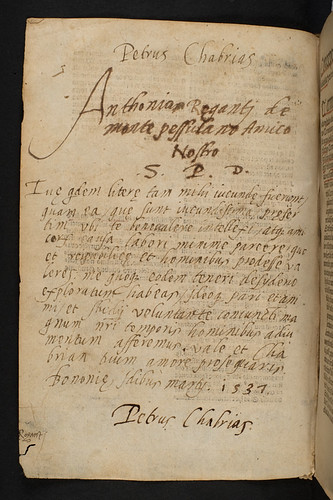Limos, Andreas.: Dubia in insolubilibus.
Paris: Félix Baligault, for Gilles de Gourmont, 30 Oct. 1499.
4to. a-g6. [42] leaves.
Woodcut initials.
ISTC il00221700; GW M18368; C3602; Oates 3108.
| GIP number: | L26 |
| Shelf-mark: | Sp Coll BC33-d.8 (see main library entry for this item) |
| Bound with: | The third of eight incunabula bound together. Bound with: (1) Magistri, Martinus, Expositio super Praedicabilia Porphyrii. Paris: Félix Baligault, for Durand Gerlier, 27 Mar. 1499 (M3); (2) Bricot, Thomas, Insolubilia; Obligationes. Paris: [André Bocard], 1498 (B107); (4) Alliaco, Petrus de, Conceptus et insolubilia. Paris: Guy Marchant, 29 Jan. 1498/99 (A45); (5) Buridanus, Johannes, Sophismata. Paris: Félix Baligault, 20 Nov. 1493 (B115); (6) Alliaco, Petrus de, Tractatus exponibilium. Paris: Antoine Caillaut, [ca. 1497] (A49); (7) Buridanus, Johannes, Consequentiae. Paris: Antoine Caillaut [ca. 1495] (B113); (8) Buridanus, Johannes, Consequentiae. Paris: Guy Marchant, 10 Jan. 1498/99 (B114). |
| Provenance: | Anthonius Rogant/Rogantus (fl. 1537), of Montpellier: inscription on g6v “Petrus Chabrias Anthonio Rogantj de monte pessulano Amico Noſtro S.P.D.” dated “Bononię, Idibus martij i537 Petrus Chabrias”; at foot of same page “Rogant”. Petrus Chabrias (fl. 1537): see above. Frater Joannes Batt[ist]a(?) (16th century): probable owner – inscription “Ad vsu[m] fratris Jo: Battãe a Calatagne” on a1r of first item in volume. Naples, Capuchins, S. Ephrem and BVM (founded 1572, suppressed 1863): probable owner; on a1r of first item is a circular book-stamp ‘BIBLIOTECAE CAPVCCINORVM CONCEPTIONIS NEAPOLIS’ heavily scored through in ink and, on the same page, a partially deleted manuscript inscription indicating the same ownership; see www.bnnonline.it/index.php?it/324/possessori/possessori_508e7ec2a179d/58 William Laing (1764-1832), Edinburgh bookseller: possibly sold book to Richard Heber – see below. Richard Heber (1774-1833), book collector: lot 5288 in Bibliotheca Heberiana, part 5 (London: Wheatley, 1835); sold for £0.2.0 according to the priced copy of the Heber sale catalogue in the British Library (shelfmark RAR 002.092 Heb), which also records that Heber himself paid £0.3.0 for the book - corroborated by a note in ink by Heber on front flyleaf “Feb. 181[2?] Laing(?) Sale of Imp[ortant](?) Books - 3 -”. Sir William Hamilton (1788-1856), Professor of Logic and Metaphysics, Edinburgh University: purchased at the Heber sale, with Hamilton’s pencil note on front flyleaf “Hebers Sale 2/”. University of Glasgow: Hamilton collection donation, 1878. |
| Binding: | Italy, 16th/17th-century parchment; faded ink spine title and shelfmark “148” at foot of spine, faded unread lettering at head of spine; front endpapers replaced in late 19th or early 20th century. Size: 215 x 145 mm. |
| Leaf size: | 203 x 137 mm. |
| Annotations: | Occasional underlining in dull red ink. |
| Decoration: | None. |
| Imperfections: | Wanting quires a-e. |




